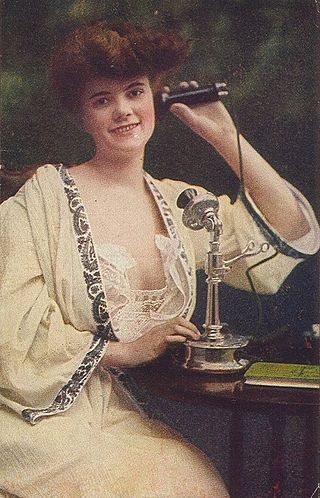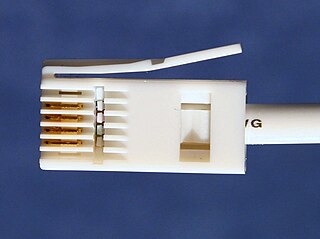Related Research Articles

A telephone switchboard was a device used to connect circuits of telephones to establish telephone calls between users or other switchboards throughout the 20th century. The switchboard was an essential component of a manual telephone exchange, and was operated by switchboard operators who used electrical cords or switches to establish the connections.

The 5ESS Switching System is a Class 5 telephone electronic switching system developed by Western Electric for the American Telephone and Telegraph Company (AT&T) and the Bell System in the United States. It came into service in 1982 and the last unit was produced in 2003.
Telephony is the field of technology involving the development, application, and deployment of telecommunication services for the purpose of electronic transmission of voice, fax, or data, between distant parties. The history of telephony is intimately linked to the invention and development of the telephone.

A blue box is an electronic device that produces tones used to generate the in-band signaling tones formerly used within the North American long-distance telephone network to send line status and called number information over voice circuits. During that period, charges associated with long-distance calling were commonplace and could be significant, depending on the time, duration and destination of the call. A blue box device allowed for circumventing these charges by enabling an illicit user, referred to as a "phreaker" to place long-distance calls, without using the network's user facilities, that would be billed to another number or dismissed entirely by the telecom company's billing system as an incomplete call. A number of similar "color boxes" were also created to control other aspects of the phone network.

In telephony, the demarcation point is the point at which the public switched telephone network ends and connects with the customer's on-premises wiring. It is the dividing line which determines who is responsible for installation and maintenance of wiring and equipment—customer/subscriber, or telephone company/provider. The demarcation point varies between countries and has changed over time.

A telephone call or telephone conversation, also known as a phone call or voice call, is a connection over a telephone network between the called party and the calling party. Telephone calls started in the late 19th century. As technology has improved, a majority of telephone calls are made over a cellular network through mobile phones or over the internet with Voice over IP. Telephone calls are typically used for real-time conversation between two or more parties, especially when the parties cannot meet in person.

A business telephone system is a telephone system typically used in business environments, encompassing the range of technology from the key telephone system (KTS) to the private branch exchange (PBX).

The DMS-100 is a member of the Digital Multiplex System (DMS) product line of telephone exchange switches manufactured by Northern Telecom. Designed during the 1970s and released in 1979, it can control 100,000 telephone lines.

An intercom, also called an intercommunication device, intercommunicator, or interphone, is a stand-alone voice communications system for use within a building, small collection of buildings or portably within a small coverage area, which functions independently of the public telephone network. Intercoms are generally mounted permanently in buildings and vehicles, but can also be detachable and portable. Intercoms can incorporate connections to public address loudspeaker systems, walkie talkies, telephones, and other intercom systems. Some intercom systems incorporate control of devices such as signal lights and door latches.

Nortel Meridian is a private branch exchange telephone switching system. It provides advanced voice features, data connectivity, LAN communications, computer telephony integration (CTI), and information services for communication applications ranging from 60 to 80,000 lines.
The BT Versatility is a telephone PBX switchboard sold by BT and targeted at small businesses. It is manufactured by Taratel Communications previously Lake Communications in Ireland as the OfficeLink. In South Africa it was sold by Tellumat as the Convergence 30 or C30, in Australia it was sold as the Commander Connect, in the USA it was sold by Inter-tel as the Encore CX and by Mitel as the Mitel 3000
In residential telephony, an extension telephone is an additional telephone wired to the same telephone line as another. In middle 20th century telephone jargon, the first telephone on a line was a "Main Station" and subsequent ones "Extensions" or even called as intercom. Such extension phones allow making or receiving calls in different rooms, for example in a home, but any incoming call would ring all extensions and any one extension being in use would cause the line to be busy for all users. Some telephones intended for use as extensions have built-in intercom features; a key telephone system for a small business may offer two to five lines, lamps indicating lines already in use, the ability to place calls on 'hold' and an intercom on each of the multiple extensions.

AT&T Merlin is a corporate telephone system by American Telephone and Telegraph (AT&T) that was introduced in late 1983, when it was branded American Bell Merlin. After the breakup of AT&T in 1984, it was rebranded and later also supplied by Lucent and Avaya.

The 1A2 Key Telephone System is a business telephone system developed and distributed by the Western Electric Company for the Bell System.
The Number Five Crossbar Switching System is a telephone switch for telephone exchanges designed by Bell Labs and manufactured by Western Electric starting in 1947. It was used in the Bell System principally as a Class 5 telephone switch in the public switched telephone network (PSTN) until the early 1990s, when it was replaced with electronic switching systems. Variants were used as combined Class 4 and Class 5 systems in rural areas, and as a TWX switch.

Microsoft Response Point was an advanced software-based telephone system developed by Microsoft. Response Point, a PBX system targeting small businesses with less than 50 employees, was launched in March 2007, with systems available on the market in the fourth quarter of that year. Response Point is VoIP-based, and uses SIP as its signaling and call setup protocol. Response Point supports voicemail and multi-party calling in addition to two party VoIP calls. Response Point features innovative voice recognition technology to manage calls and voice mail. Voicemail messages can, optionally, be sent to e-mail where they can be retrieved and archived. Response Point voice dialing can work with the Response Point phone directory which is currently limited to 1100 contacts per user. Contacts may be imported from the Windows Address Book or Microsoft Outlook. Response Point automatically detects gateways and phones connected to the network.

British telephone sockets were introduced in their current plug and socket form on 19 November 1981 by British Telecom to allow subscribers to connect their own telephones. The connectors are specified in British Standard BS 6312. Electrical characteristics of the telephone interface are specified by individual network operators, e.g. in British Telecom's SIN 351. Electrical characteristics required of British telephones used to be specified in BS 6305.

A modulator-demodulator or most commonly referred to as modem is a computer hardware device that converts data from a digital format into a format suitable for an analog transmission medium such as telephone or radio. A modem transmits data by modulating one or more carrier wave signals to encode digital information, while the receiver demodulates the signal to recreate the original digital information. The goal is to produce a signal that can be transmitted easily and decoded reliably. Modems can be used with almost any means of transmitting analog signals, from light-emitting diodes to radio.
Ringing is a telecommunication signal that causes a bell or other device to alert a telephone subscriber to an incoming telephone call. Historically, this entailed sending a high-voltage alternating current over the telephone line to a customer station which contained an electromagnetic bell. It is therefore also commonly referred to as power ringing, to distinguish it from another signal, audible ringing, or ringing tone, which is sent to the originating caller to indicate that the destination telephone is in fact ringing.

A telephone exchange, also known as a telephone switch or central office, is a crucial component in the public switched telephone network (PSTN) or large enterprise telecommunications systems. It facilitates the interconnection of telephone subscriber lines or digital system virtual circuits, enabling telephone calls between subscribers.
References
- ↑ Main, Max (2003). HTI+. Que. pp. 165, 169. ISBN 9780789729378 – via Google Books.
- 1 2 Peterson, Kerstin (2000). Business Telecom Systems: A Guide to Choosing the Best Technologies and Services. CRC Press. pp. 80–81. ISBN 9781482294569 – via Google Books.
- 1 2 3 4 5 Green, Andy (May 2001). "Keeping it Simple with KSU-less". Teleconnect. 19 (5). UBM LLC: 52. Archived from the original on January 11, 2002.
- 1 2 Klein, Jack (December 1990). "Another Solution: Today's KSUless Technology Can Benefit Your Centrex Service". Teleconnect. 8 (12). UBM LLC: 87 – via Gale.
- ↑ Marcus, Michael N. (June 1995). "KSU-less Key System Update". Teleconnect. 13 (6). UBM LLC: 117 et seq. – via Gale.
- ↑ Gundlach, Richard (December 11, 1975). "Telephones at 100: Transformed by technology for new functions". Electronics. 48 (25). McGraw-Hill: 90–100 – via the Internet Archive.
- ↑ Newton, Harry (1994). Which Phone System Should I Buy?. Flatiron Publishing. p. 7-2. ISBN 9780936648590 – via the Internet Archive.
- 1 2 3 The Essential Business Buyer's Guide. Sourcebooks. 1997. p. 201. ISBN 9781570711305 – via the Internet Archive.
- ↑ Brooks, Matthew (October 1995). "Telecommunications for the home office". Managing Office Technology. 40 (10). OfficeVision: 8 – via Gale.
- ↑ Jainschigg, John B. (March 1996). "Bye-bye busy signal". Home Office Computing. 14 (3). Line56: 94 et seq. – via Gale.